




Chimney Meadows’ pioneering past, present and future
Berkshire
Buckinghamshire & Oxfordshire
Wildlife Trust
Celebrate the winners of our Photography Competition
COLD COMFORT
Discover what frogs and toads do over winter

Since the General Election we have been reaching out to meet all our local MPs, ensuring that nature recovery is forefront of their minds. We are encouraged by the positive response, not least by the five MPs who attended the recent chalk streams debate in Parliament. Globally, chalk streams are incredibly rare and 85% of them are found in Southern England, making our work to protect and restore them vitally important.
Our three-year Nature Recovery Fund appeal has run for a full year now, with £500,000 raised at the time of going to press. But with our target set at £3m we desperately need more funds to ensure we can involve even more people and restore nature on a landscape scale.
BBOWT is in a unique position to make this happen locally and we can demonstrate this expertise on our own nature reserves and through partnerships with others – for instance, at Chimney Meadows where we are facilitating more naturefriendly development through our innovative Biodiversity Net Gain work, which you can read about from page 10.
We touch the lives of people across our three counties, supporting a closer connection with nature. Great examples of this include our Wild Bicester and Wild Banbury projects or our work in Slough as part of Nextdoor Nature, all of which you can learn more about on page 12.
It’s important we all make time to spend surrounded by the wonders of wildlife. Time in nature grounds us, keeps us mentally and physically fitter, and gives us a reason to fight for nature’s recovery.
I hope you manage to take some time out over the busy coming weeks, to visit one of our nature reserves or simply stop, breathe and admire the beauty of the natural world around us. With thanks to you all for your continued support, you are part of a unique movement of people taking action for wildlife.

Estelle Bailey, Chief Executive

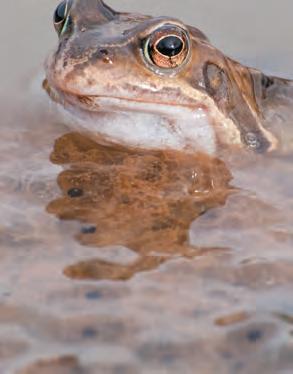



Wild Berks, Bucks & Oxon is the membership magazine for Berks, Bucks & Oxon Wildlife Trust
Contact 01865 775476, info@bbowt.org.uk
Membership 01865 788300, membership@bbowt.org.uk
Address The Lodge, 1 Armstrong Road, Littlemore, Oxford OX4 4XT
Website www.bbowt.org.uk
President Steve Backshall
Chair George Levvy
Chief Executive Estelle Bailey
Wherever you are in the country your Wildlife Trust is standing up for wildlife and wild places in your area and bringing people closer to nature.
Wild Berks, Bucks & Oxon is brought to you by Editor Benedict Vanheems
UK Consultant Editor Joanna Foat
UK Consultant Designer Ben Cook
Design Yorkshire Wildlife Trust Design Studio
Print CKN Print Ltd
Cover Richard Steel/2020VISION

A large-print version of Wild Berks, Bucks & Oxon (text only) is available on request. Call 01865 775476 or email info@bbowt.org.uk
Enjoy the extended version of Wild Berks, Bucks & Oxon online at bbowt.org.uk/publications




There’s plenty to keep us full of awe this winter.
Amphibians hibernate in winter, don’t they? Certainly frogs, toads and newts spend the winter in dark, damp places, but they are not hibernating in the way some mammals do, they are just in a very deep sleep.
All amphibians are cold-blooded, meaning their body temperature depends on their surroundings, and they are less active when temperatures drop. Some scientists prefer the term ‘brumation’ for the period when amphibians have low metabolic function and move slowly.
On warmer days amphibians temporarily emerge from their winter hideaways to feed and drink. Some male frogs spend the winter in sediment at the bottom of a pond or old washing up bowls dug into the ground. They will survive winter so long as there is oxygen for them to breathe through their skin. Others find refuge beneath the relative warmth of compost heaps and log piles. You can help by stacking dead wood with leaves and soil in the autumn to create a safe place for brumating amphibians. Sweep snow and frost from frozen ponds to let light in. Maintain a small hole by floating a
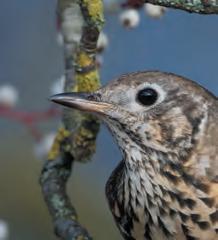
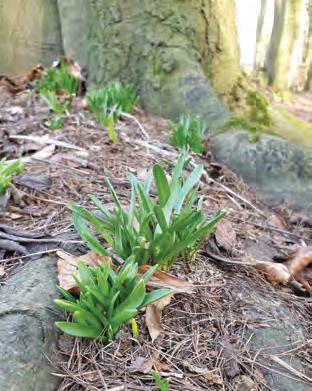
Frogspawn beneath any surface ice should survive. Frogs continue to mate and produce spawn through to springtime. Newts and toads lay their spawn later in spring, usually after the risk of frost.
tennis ball on the surface then remove it once the surface has frozen over. This enables other wildlife to drink from the pond while ensuring more oxygen can reach the water.
Help garden wildlife survive the winter chill. For more tips visit: bbowt.org.uk/actions/help-wildlife-cold
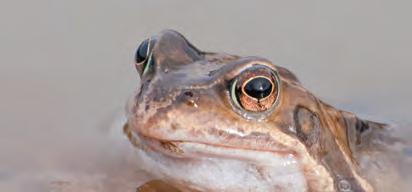

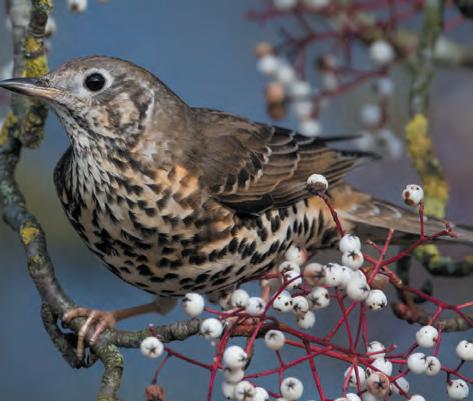
Thrushes are a delight to see and hear. In fact, listening to them may be the best way to tell them apart. On cold winter nights the high-pitched ‘seeep, seeep’ call of the redwing indicates a flock passing overhead. Raucous ‘chack, chack, chack’s come from fieldfares on the lookout for berry-laden trees in farmland hedgerows. Mistle thrushes are noted for their dry rattle of a call and live here year-round. In winter they might perch atop holly trees defending their larder, or dangle precariously feeding on clumps of mistletoe.
Look for bluebell leaves piercing the woodland leaf litter. They will absorb the gentle sunlight, feeding the flower buds still forming below ground.
It may not feel like it, but the first hints of spring will soon be upon us.
Mosses
Verdant mosses and colourful lichens are easy to spot after winter rain. Look for them in churchyards, woodlands and growing on walls. There are over 750 species of moss in Britain.
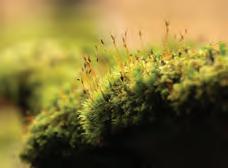
Nesting rooks
Noisy rooks start building their nests of twigs high up in trees from January. These social communities, known as rookeries, can contain hundreds of birds.
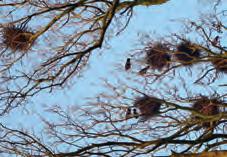
Winter aconites and snowdrops were introduced to gardens and parks in the 16th century. Now naturalised, they make impressive displays.
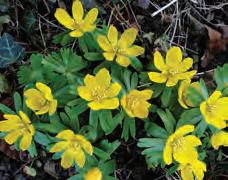
Listen for the buzz of a queen bumblebee in a crocus flower. She’s on the search for nectar and will get caked in pollen as she delves deeper to reach it.
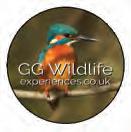
The stunning results of this year’s Photo Competition are in. Congratulations to our winners!
Judging the BBOWT Photography Competition doesn’t get any easier, particularly given the ever-upwards standard! But after much deliberation, head scratching and pure awe, we can reveal the winners.
The judges unanimously agreed on Luke Chambers’ remarkable shot of an armed nomad bee as our overall winner. Luke secures a Technaxx bird feeder camera station, while all winners earn the chance to enjoy a workshop with wildlife photographer Steve Gozdz of GG Wildlife Experiences, as well as featuring in our 2025 calendar. New for this year is our People’s Choice Award, which goes to Peter Hines for his close-up portrait of the iconic robin.
Well done to everyone who entered. We were so impressed by the quality of this year’s entries. You can admire all the winning, runner-up and highly commended photos at bbowt.org.uk/photocomp24
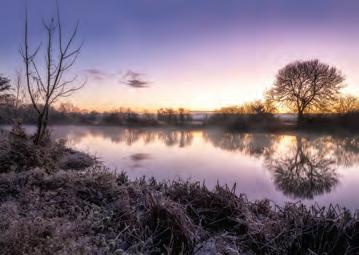
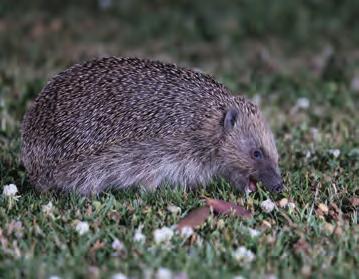
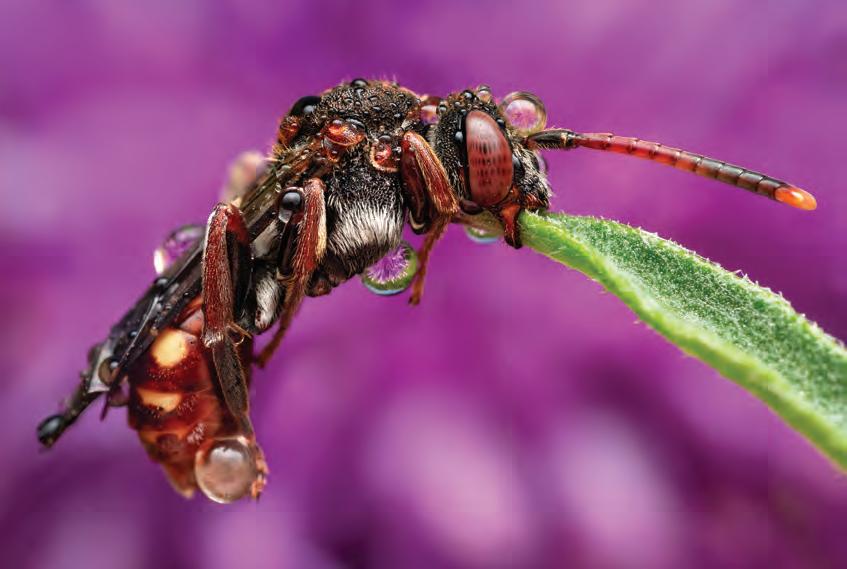
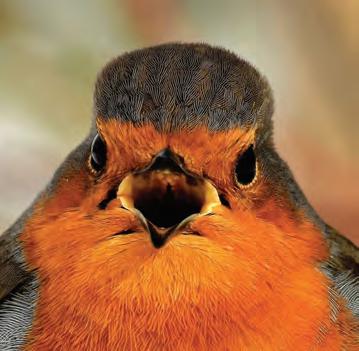
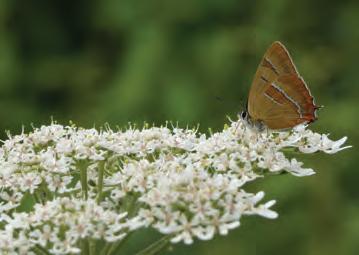
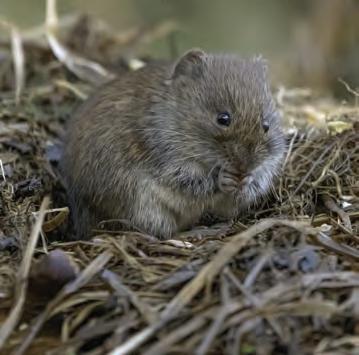
Buy the calendar
Grab your copy of the 2025 calendar for just £10. All proceeds go towards helping local wildlife. Order online while stocks last at bbowt.org.uk/wildlife-calendar-2025
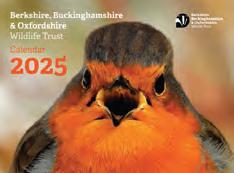
Without our volunteers we wouldn’t be able to achieve nearly as much for wildlife. It’s why we recognise their incredible contributions through our annual Volunteer Awards.
This year we celebrate two long-serving volunteers with Lifetime Achievement Awards. John Melling has been surveying birds at Chimney Meadows for 20 years and was involved in work parties for several years. Graeme Stewart is another keen bird surveyor in the Newbury area who started leading his popular guided walks at Thatcham Reedbeds and
Greenham Common back in 2002.
As well as outstanding individual and group contributions, we also recognise for the first time a young volunteer. Congratulations to Connie Butler, who empowers other young people to act for nature by helping out at Sutton Courtenay’s Young and Teen Rangers clubs.
Of course, all our volunteers deserve praise, and we are truly grateful for their dedication to local wildlife. View the full list of winners at bbowt.org.uk/volunteer-awards
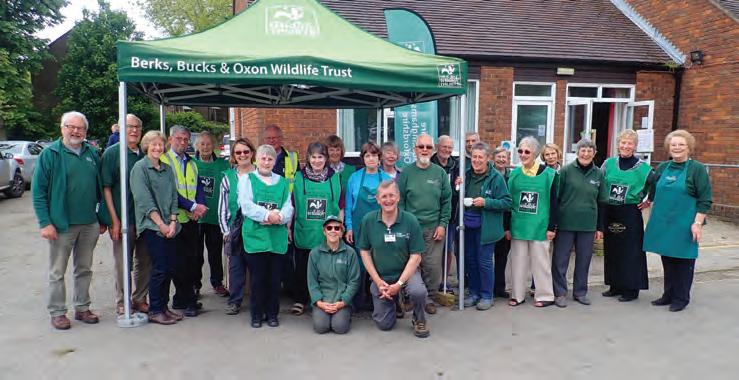
It’s been a year since we launched the Nature Recovery Fund, our biggest-ever fundraising appeal. More than £500,000 has been raised so far, but with a target total of £3m to reach over the next two years, there’s still some way to go. Money donated is already making an impact. For example, we are creating more scrapes and pools for birds like curlew, reaching out to more decisionmakers, politicians and landowners, and are able to support the more than 200 volunteers who started with BBOWT over the past year.


Thank you to everyone who has donated. Your kindness is helping wildlife right now. If you haven’t yet donated, please consider doing so. Simply visit bbowt.org.uk/SOS to give today, phone 01865 788300, or text RECOVERY followed by your donation amount to 70480.
Visit bbowt.org.uk/ newsletter to sign up for our latest news, delivered to your inbox.
BBOWT was founded in 1959 (as the Berks, Bucks and Oxon Naturalist Trust) by local ecologists who could see the harm being done to the local natural environment. Today, as we celebrate 65 years, we have more than 60,000 members – our highest number in history. It is your support that enables our vital work – work that is more important than ever.

Welcome to our newest Investor in Wildlife business members: Bowles & Wyer, CH&Co Catering, and Travel Antares. Renewing their memberships, we are grateful to Berkeley Homes, Sophos IT, St John’s College, and University College Oxford. To explore the variety of ways that your business can act for nature contact us at partnerships@bbowt.org.uk
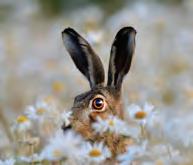

We are delighted to have restarted our popular Nature Memories Café. The monthly sessions at the Nature Discovery Centre in Thatcham offer an opportunity for those living with dementia to come together and enjoy nature-themed crafts, coffee and cake, or to simply chat with new friends. For details of future dates visit bbowt.org.uk/events
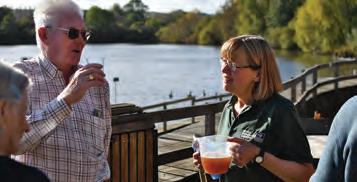
A pioneering series of reports have revealed the vast amount of carbon stored within UK marine habitats, and the importance of protecting UK seas for tackling climate change.
The seas around the UK and Isle of Man cover nearly 885,000 square kilometres – over three times the size of the UK’s land mass. This vast area is host to different habitats that sequester and store carbon, known as ‘blue carbon’. They include seabed sediments, seagrass meadows, saltmarshes, kelp forests, intertidal seaweed beds, maerl beds and biogenic reefs, such as mussel beds and honeycomb worm reefs.
The Blue Carbon Mapping Project, completed by the Scottish Association for Marine Science (SAMS) on behalf of The Wildlife Trusts, WWF and the RSPB, is the first time a country
has provided a comprehensive estimate of the carbon captured and stored in its seas, including within Marine Protected Areas (MPAs).
The report finds that 244 million tonnes of organic carbon are stored in just the top 10 centimetres of seabed sediments – principally made of mud – plus coastal habitats including saltmarshes and seagrass beds. The reports identify bottom trawling and offshore energy installation as the biggest potential threats to blue carbon stores.
The Wildlife Trusts, WWF and RSPB are calling on governments across the UK to strengthen protections for the most valuable and vulnerable blue carbon stores.
Find out more at wtru.st/blue-carbon-report

Sir David Attenborough has been awarded the Rothschild medal in recognition of the extraordinary leadership, inspiration and indefatigable support he has given to The Wildlife Trusts federation of charities over the past 60 years.
Charles Rothschild founded the Society for the Promotion of Nature Reserves which would later become The Wildlife Trusts. He was ahead of his time in recognising the need to protect natural habitats and the wildlife that lived there.
His daughter, Miriam, was a visionary scientist who dedicated her life to the natural world.
Sir David Attenborough credits Leicestershire & Rutland Wildlife Trust’s Tilton Cutting Nature Reserve with giving him his love of the natural world –he would explore it and search for fossils there as a young boy. Since then, Sir David has championed the work of the Wildlife Trusts across the UK for six decades.
Discover how The Wildlife Trusts are helping wildlife across the UK

Manx Wildlife Trust and theatre company, Hello Little People, have launched an audio-immersive wildlife training academy for kids, Let’s Get Wild! Wearing silent disco-style headphones, 5–9 year-olds move, shake and dance through an action-packed adventure to complete challenges and help save wildlife in the Isle of Man. wtru.st/LetsGetWild
North Wales Wildlife Trust have been taking an innovative approach to tackling invasive plant species. Using a limited time only mobile game, players completed ‘missions’ by locating and recording the garden escapees, along pavements in urban areas or in nature reserves. Players were paid £1 for each new observation of target plants. wtru.st/GardenEscapers
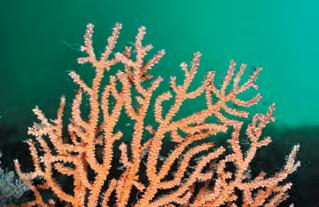
Off the Alderney coast, citizen scientists scuba-dive and snorkel for small tissue samples of the pink, warty looking soft corals of pink sea fans. Research by Alderney Wildlife Trust, University of Exeter and Jersey Marine Conservation is assessing their genetic connectivity across the rocky reefs of the Channel Islands. wtru.st/PinkSeaFans
present
Many people buy BBOWT membership as a Christmas gift for someone they love, which helps us maintain our beloved reserves. Thank you from us!

Work off festive feasts with a bracing hike through a winter wonderland, and if you’re lucky catch the first signs of spring.

Postcode OX3 9TY
Great for… Secluded walks
Size 22 hectares
Map ref SP 559 096 what3words pushed.shakes.harsh

Even in the depths of winter, life is heating up in the woods at Sydlings Copse. As December turns to January, red fox breeding season builds to its peak. Look out for males doggedly following vixens even in daylight while waiting for them to become receptive.
Another mammalian marvel you can catch at this site in winter is the weasel – our smallest native carnivore with a handsome russet-brown coat and creamy white throat.
Then as February arrives, watch for the yellow flash of the first brimstone butterflies as they flutter out from their winter hibernation in the woodland ivy. Among the first flowers they can rely on for nectar are the custard-coloured, coconut-scented blooms of the spiky gorse
bushes, followed later by cowslips and hairy violets in the flower-rich grassland.
One of the real highlights of this reserve is the strange-looking toothwort plant. A parasite on the roots of hazel, elm, alder and willow, its pale stems push up through the leaf litter in March. Said to resemble rows of discoloured teeth, the white flowers that follow in April were once held to be a surefire cure for toothache.
The circular Wildlife Walk is a great way to burn off any unwanted Christmas calories – just follow the badger waymarkers along the three quarters of a mile route. Or if you fancy a real workout, we also run regular volunteer conservation work parties at Sydlings Copse. Email volunteering@bbowt.org.uk to find out more.
Postcode RG7 6QH
Great for… Majestic oaks
Size 345 hectares
Map ref SU 537 688 what3words annotated. crispier.shark
Bucklebury Common is a sprawling patchwork of oak, ash and beech woods. Until the 20th century it was mostly heath where commoners grazed sheep and cattle on heather and
cut gorse for fuel. When this stopped, birch started to recolonise, but the remaining heathland is still home to cryptic nightjars that arrive each summer to nest. Winter is a great time to admire the grand architecture of the majestic oaks, many of them hundreds of years old, and on mild days in early spring you might spot the first common lizards and grass snakes sneaking out to sunbathe.

Some sites we manage are privately owned, only accessible via public footpaths, while at others fragile habitat is easily damaged by trampling. So wherever you wander this winter, please stick to the paths.
There’s still lots of wildlife to see in winter – if you know what you’re looking for! Make a walk in the woods even more fun for little nature lovers by downloading one of our spotter sheets, then tick off what you find. Go to wildlifewatch.org.uk/activities
Postcode OX5 2RF
Great for… Hares and hairstreaks
Size 63 hectares
Map ref SP 600 150 what3words gravy.belonged. upwardly
This green corner between Oxford and Bicester has been wooded since at least 1600, with its mix of old oak, ash, birch and willow providing fertile territory for fungi
such as the delicate amethyst deceiver. The circular Wildlife Walk (two-and-a-quarter miles) also takes in the open rides we maintain between the trees for butterflies, including the rare brown and black hairstreaks that live here. From February primroses flourish in the old coppice area and by March you can even see hares boxing in the rides as mating season begins.
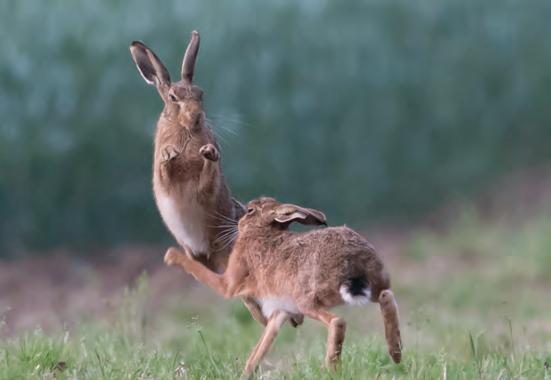
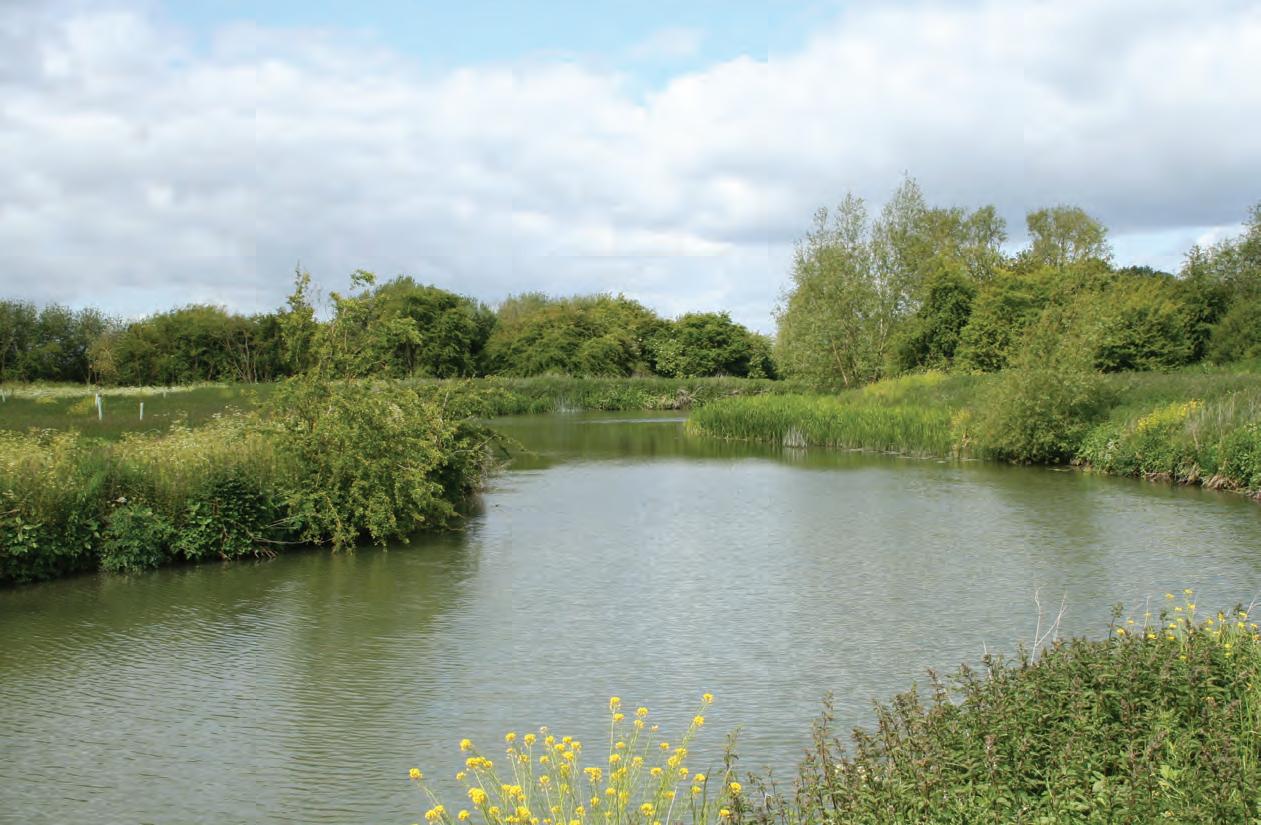
Chimney Meadows is a precious wildlife haven. Once a commercial farm, the past 20 years have seen this tranquil corner of Oxfordshire restored to glorious, species-rich wildflower meadows. Head of Ecology Debbie Lewis tells the story of its remarkable transformation.
In 2003 BBOWT took on a significant addition to our estate.
Chimney Meadows National Nature Reserve (NNR) was an often-overlooked wildlife haven, being remote and difficult to access, but then came the opportunity to buy the neighbouring 198 hectares of farmland. What followed was the biggest land purchase the Trust had ever undertaken. Thanks to the generosity of trusts, grant bodies and
many individuals, the money was raised, and Chimney Meadows nature reserve born.
Unimproved grasslands, such as those at the NNR, have declined by 97% since the 1930s and the new land at Chimney provided the ideal opportunity to restore floodplain meadows and start to reverse this loss. The following summer we began the conversion of the arable fields back into flower-rich hay meadows.
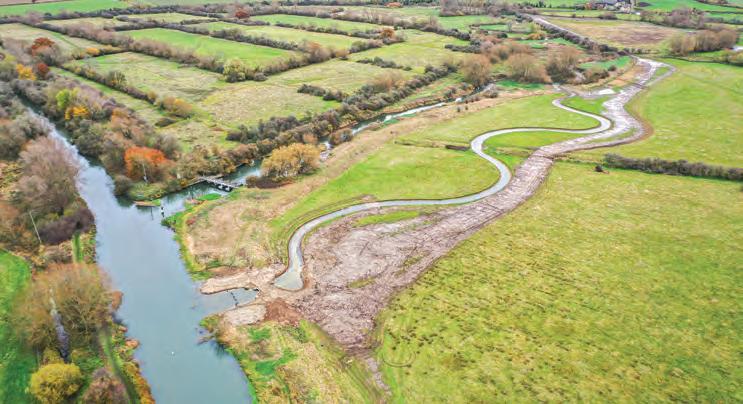
The new river channel is helping fish to reach further upstream
Chimney Meadows is the only nature reserve to span both banks of the Thames
At the time Chimney was the largest arable to grassland reversion project ever undertaken and seed suppliers simply couldn’t provide enough of the seed we needed. So instead, we used the relatively new and pioneering approach of spreading ‘green hay’.
The arable fields were prepared by creating extensive bare ground and removing undesired weeds. In midsummer the hay in the NNR was cut as normal, but this time gathered up and immediately spread across the open ground, transferring the wildflower seeds in the process.
It was a long wait until spring to see whether the green hay had been a success. After an initial flush of arable species such as poppies, the fields began to settle down and develop the desired mix of perennial wild flowers.
So what do the fields look like today, 20 years after they were restored to grassland?
Last year several surveys were made to answer this question. The results

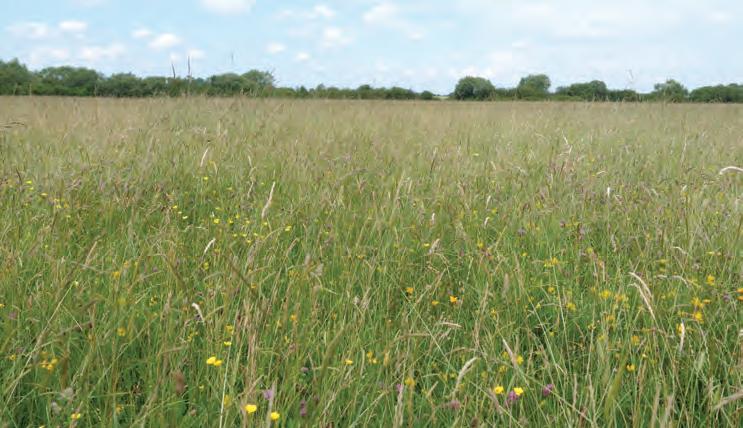
show that the vast majority of fields have been very successful in restoring wild flower diversity, both in terms of the increasing number of positive floodplain meadow indicator species and the reducing frequency of weedy species such as thistles and docks. The diversity of associated species like ground beetles has also steadily improved.
Reaching this point hasn’t been without its challenges, with extensive flooding in 2007 and 2012 making it impossible to take a hay cut, which in turn impacted wild flower abundance in the years immediately following. Nevertheless, over the past two decades Chimney Meadows has continued to grow like an ever-expanding jigsaw. Slowly we are creating a picture of a healthy, functioning landscape.
In 2017 we added another 46 hectares. This area, known as Duxford Old River, meant that for the first time we owned land on both sides of the Thames, bringing with it the chance to develop river connectivity. With the help of a significant grant from the Environment Agency we created a new river channel joining up two stretches of the Thames, previously blocked by a weir. This has enabled fish to swim further upriver to spawn.
Matt Morrison-Clarke, Business Development Manager, shares an exciting new development for Chimney Meadows.
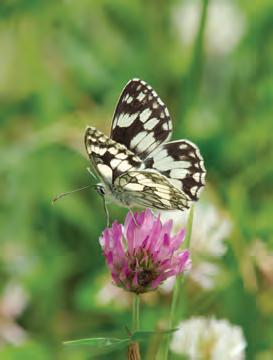
Last year saw the end of a three-year project funded by Ecover to investigate how floodplain meadows like those found at Chimney Meadows store soil carbon. Tree planting is often seen as the best option for locking up carbon, but this isn’t always appropriate.
Working closely with local partners and the Open University, we assessed how effective ancient meadows, restored meadows and arable fields are at locking away carbon within the soil. Preliminary results reveal that ancient meadows store roughly twice as much carbon as arable fields, with restored grasslands somewhere between the two. This shows that as well as protecting existing ancient floodplain meadows, restoring fields, such as those at Chimney, can also prove invaluable in fighting climate change. It was also interesting to discover that the total carbon stored in species-rich ancient meadows is more than that in ancient woodland.
As the research reveals, not only is Chimney a great success story for wildlife, it also offers benefits for people and the environment through carbon storage, flood water storage, and engagement with nature through the many landowners, schoolchildren and wildlife visitors who come to explore.
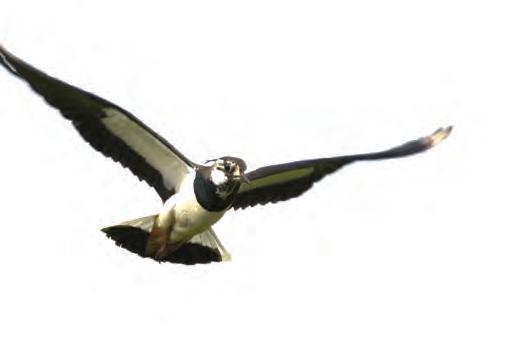
The last 20 years have been amazing, but our achievements were only possible thanks to the dedication of the volunteers who help manage the site, and donations from our supporters like you. So thank you all very much – here’s to the next 20 years.
The land at Duxford Old River has presented another opportunity through the emerging market for Biodiversity Net Gain, which can provide long-term funding for projects to deliver wildlife improvements through habitat creation and improvements. This has come about because of the Environment Act 2021, which introduced legislation to ensure that development in England now results in more and betterquality natural habitats, either on the development site itself or at an equivalent parcel of land elsewhere (known as a ‘habitat bank’).
BBOWT has entered into a legal agreement with Vale of White Horse District Council to manage and monitor the restoration of specific habitats at Duxford over the next 30 years. The measurable uplift in biodiversity is an asset we can sell to developers unable to achieve sufficient uplift on their own sites. BBOWT will retain complete ownership and responsibility for Duxford and by managing the site as a habitat bank, we are supporting responsible development through improvements to biodiversity funded through this new legislation.

Live nearby? Why not join the Friends of Chimney Meadows volunteer work party. Volunteers meet fortnightly to complete a range of tasks. Full training is given and you will meet friendly, likeminded people. For details visit bbowt.org.uk/chimney-meadowsvolunteer-work-party
Our
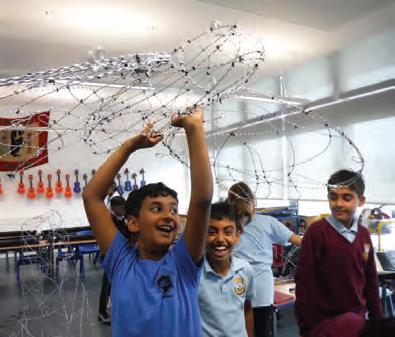
Our Nextdoor Nature project came to an end in September. Made possible thanks to funding from the National Lottery
The Wild Bicester and Wild Banbury projects also aimed to encourage more people to engage with the natural world.
Wild Bicester, funded by Cherwell District Council and Bicester Town Council, brought nature-based activities to the town, including a series of wildlife walks, nature craft activities and talks. The project worked with local green groups such as Harvest at Home, Langford Community Orchard and Bicester Community Wellbeing Garden to support their practical conservation efforts and raise their profile.
Wild Banbury, also funded by Cherwell District Council, has been running for more than a decade. The project has supported the Wild Banbury Volunteer group in completing conservation tasks in and around Banbury. Group members can be seen improving a range of habitats
Heritage Fund, Nextdoor Nature was delivered by 46 different Wildlife Trusts, including BBOWT.
Over the past two years we worked with groups in Reading and Slough to connect people with nature. Activities were organised by and for local communities with the support of our project officer and covered a broad range of actions, such as rewilding an unloved patch of grass, growing vegetables, building ponds and litter picking. This approach was very different to traditional conservation work, as actions were taken in local, urban areas.
Disengagement with the outdoors has deep-rooted causes. By understanding these and promoting healthy dialogue, we were able to deliver 12 community
within Spiceball Park and other green spaces. The project has worked closely with Hanwell Fields Community Centre over the last year, providing monthly events such as bat walks, nature talks and activities like building bee hotels. Further support has also extended to local green groups Harvest at Home, Keep Nethercote Rural and Bridge Street Community Garden.
While both projects come to an end this December, there are still many active green groups and naturebased activities running in each area, ensuring people can continue to connect with nature and make a difference for wildlife. The projects also retain active Facebook groups.
projects and engage a further 24 local organisations, from schools and councils to businesses and charities. We worked with a diverse range of communities, including underserved groups to install more than 50 bird, bat and hedgehog boxes, bug hotels, and two wildlife ponds. Four churchyards are now managed for wildlife, while seven community gardens are managed for the benefit of wildlife and people.
Contact with nature improves mental and physical wellbeing, so helping those who struggle to access the outdoors to do so has been crucial to the delivery of Nextdoor Nature. The project’s legacy means more people can now experience the joy of nature, wherever they are.
#TeamWilder
Discover more ways to get closer to nature. Join in at bbowt.org.uk/ team-wilder
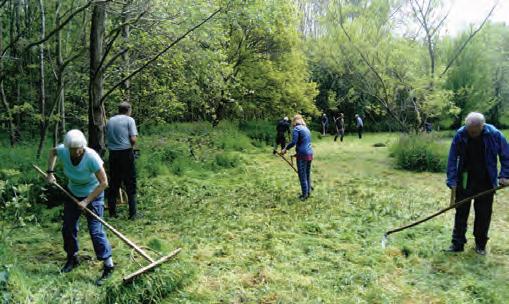


Including a gift to BBOWT in your Will is a thoughtful way to leave a legacy that continues helping wildlife long after you are gone.

Members of the Legacy Society enjoy a tour of Meadow Farm, Upper Ray Meadows
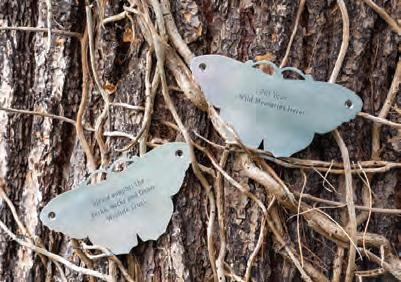
Gifts in Wills have such a positive impact, enabling us to do more for local wildlife.
Previous gifts have secured the long-term future of nature reserves, helped train more people to protect wildlife, and secured the resources we need to lead nature’s recovery in our region.
Last year we launched the Legacy Society as a way of saying thank you for the incredible gesture of remembering BBOWT in your Will. Members receive
This summer our Philanthropy Team delivered a unique evening to thank our high-level supporters and those who have pledged a gift to BBOWT in their Will.
On a warm July evening, we were honoured to work with Ascot Lloyd –Independent Financial Advisers to deliver an evening with Isabella Tree at the Oxford University Museum of Natural History. In front of an enthusiastic audience, Isabella discussed her latest book, which inspired the recent film Wilding. Drinks and canapés followed among the dinosaurs in the Main Court of the museum.
an annual digital newsletter as well as invitations to special behind-the-scenes events to meet up and enjoy the wildlife we all love, together.
Joining this programme is completely optional but we hope all of those who have feel valued, as our work only exists because of your remarkable support.
To find out more, please contact our Legacy Officer, Miriam Murphy by email at miriammurphy@bbowt.org.uk

We are extremely grateful to Ascot Lloyd for sponsoring this evening. For details about their services please visit ascotlloyd.co.uk
For more information about our Philanthropy Programme please get in touch with Laura Pepper by email at laurapepper@bbowt.org.uk
What better way to celebrate a special person, occasion or landmark than with one of our beautiful commemorative butterfly plaques? The elegantly crafted butterflies offer a thoughtful way to mark an engagement, marriage, special birthday, favourite family walk or perhaps remember a loved one – all while raising essential funds for our much-needed conservation work.
Priced at £250, each butterfly can be engraved to order with the wording of your choice. The butterflies are available for display at College Lake, Tring and the Nature Discovery Centre, Thatcham. Your purchase could help provide training for volunteers working on butterflyfilled wildflower meadows, pay for equipment for a young conservation trainee, and so much more!
By way of thanks, BBOWT is delighted to host an annual Celebrate and Commemorate event at both College Lake and the Nature Discovery Centre for friends and family to celebrate the special memories on their butterfly plaques and to enjoy a guided walk and refreshments together.
To order your commemorative butterfly plaque please visit bbowt.org.uk/your-wild-memories or call 01865 775476.
Wreath Making Workshops
Join us this festive season for our fun and creative adults-only wreath making workshops using locally collected materials. This is a great way to add a touch of nature to your front door, or why not make a unique gift for a loved one? Booking essential.
Woolley Firs Environmental Education Centre (Berks)
Thurs 5 Dec, 6.30pm & Fri 6 Dec, 10am
Sutton Courtenay Environmental Education Centre (Oxon) Thurs 5 & Fri 6 Dec, 6pm
Home Spun
Can’t make our wreath making workshops? Then purchase a wreath making kit to take home and enjoy at your leisure. Order in advance to pick up on 5 or 6 December from Sutton Courtenay Environmental Education Centre, Abingdon, OX14 4TE.
Half term events
Get set for the February half term with our range of day camps and workshops.
Day camps
Fully supervised camps for ages 8–12. Join us for fun activities, nature exploring and to meet friends new and old.
Nature Explorers
College Lake, Tues 18 Feb
Winter Wildness
Sutton Courtenay, Weds 19 Feb
Winter Safari
Woolley Firs, Weds 19 & Fri 21 Feb
Wild Discovery
Windsor Great Park, Weds 19 & Fri 21 Feb
Highlights from our busy events diary. For full and up-to-date listings or to book visit bbowt.org.uk/events
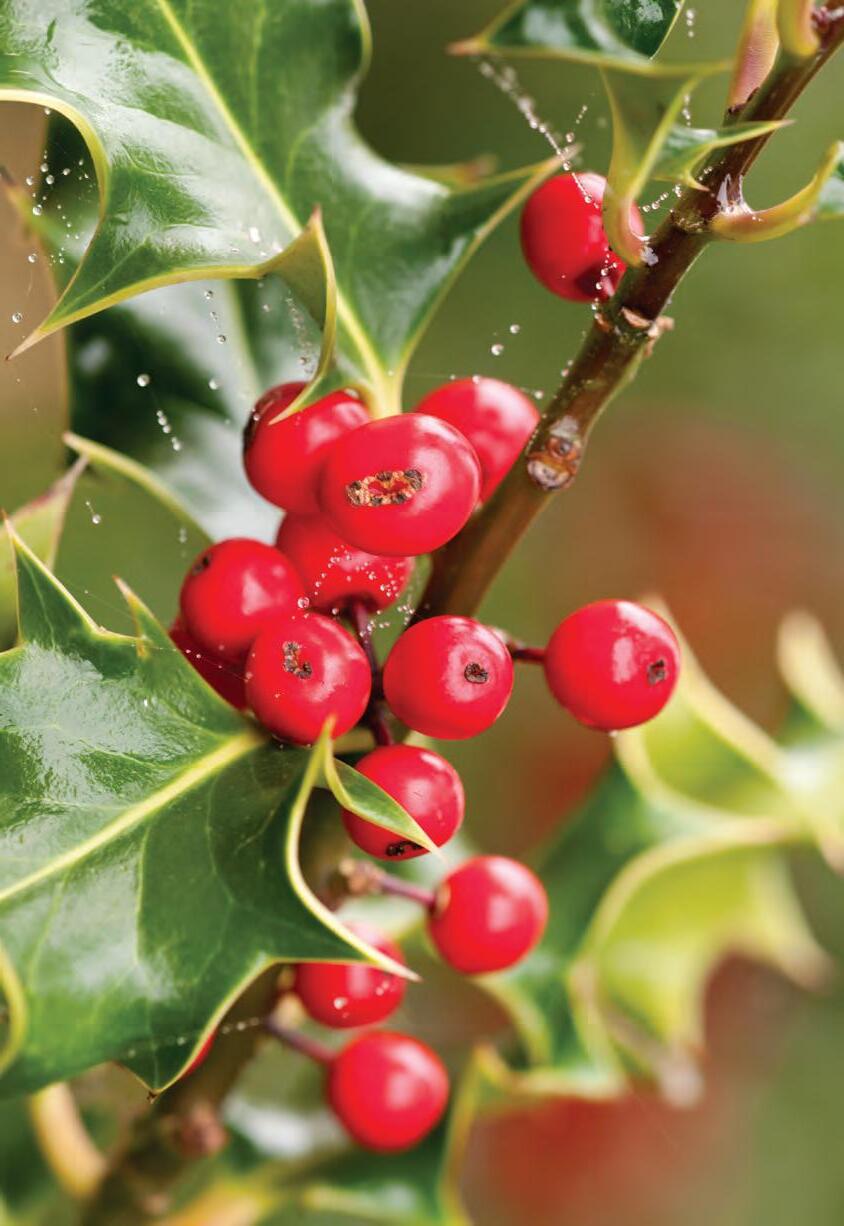
Wild Stories and Mask Making
Sutton Courtenay, Tues 18 Feb
Fun for families with children aged 4–11 years.
Poo and Other Clues
College Lake, Weds 19 Feb
Find out what animals leave behind to tell us about life at our nature reserve in winter.
College Lake, Weds 19 Feb
Become a pond explorer and fall in love with the wonderful creatures who live under water!
Make a Bird Box
Sutton Courtenay, Thurs 20 Feb Workshop for ages 7+.
Make your own bird box to welcome nesting birds into your garden.
Wildlife Quiz
Nature Discovery Centre, Weds 19 & Fri 21 Feb
Put your wildlife knowledge to the test with puzzles and games in this escape roomstyle family day out.
All events can be booked at bbowt.org.uk/events
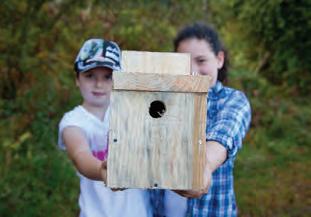
Ignite a lifelong passion for nature in the younger members of your family. Throughout the year we run our very popular Nature Tots sessions aimed at pre-schoolers. For older wildlife enthusiasts there’s our Young Rangers club for ages 8–11, while those aged 11–17 can join in our Teen Rangers sessions. The homeschooling community is well catered for with our Home Educators Days at Woolley Firs and Sutton Courtenay Environmental Education Centres.
And, of course, we welcome adults too through our muchloved monthly events, including Nature, Natter and Nibbles at Sutton Courtenay, Bird Walks at the Nature Discovery Centre (Berks), and many more. For further details, dates and to book, please visit bbowt.org.uk/events
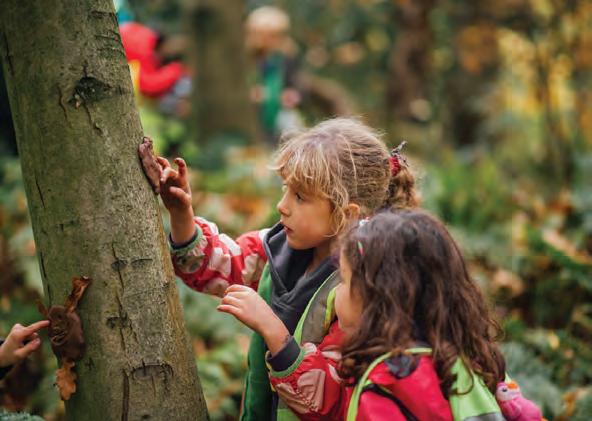

@rhianesworld
I am a person who cannot stay still for very long. Hiking and going on adventures are part of my DNA. Whether it’s discovering new corners of the world or right here at home in the UK, getting outdoors is so good for our physical and mental health. Plus, there is so much to see and learn about; we share the planet with so many amazing flora and fauna.
As a child, I would spend time playing outside with my friends at the park, running down alleys to the brook behind my house. We used to go looking for black and white caterpillars and frogs, and we would leave water out for the hedgehogs living in our garden. Sadly, you don’t see them anymore, which is one of the reasons I am so excited to be working with The Wildlife Trusts, to find ways to inspire young people to connect with and save nature. Hopefully, we can bring our spiky friends back from the brink.
In school, I always enjoyed spending time outdoors doing sports: cross-country running, rounders and netball. But when I started work, I lost that connection to the outdoors and nature. This is something I hear from people all over the UK – they are desperate to connect with the environment but not sure how. That used to be me.
If you live in an urban area, it’s hard to find like-minded people who want to experience the outdoors. When you do find groups, most people are white. It’s not that those groups are all unwelcoming to a black woman, it’s just that there are shared cultural experiences that only black women experience. I find strength, security and bonding in those situations.
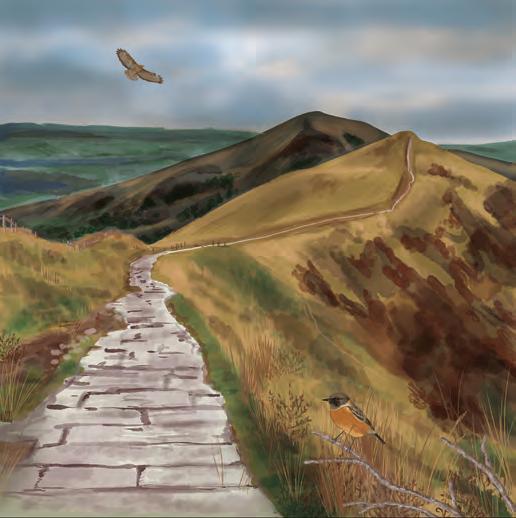
But we needed to challenge stereotypes in outdoor adventure and within our community. So, I started Black Girls Hike, a small weekly meet-up group of nine or 10 people so that we were among like-minded and non-judgmental people. BGH is owned by the members, and collectively we challenge the norms and break down barriers for future generations. Now Black Girls Hike is a multiaward-winning national organisation with tens of thousands of members.
I love exploring different terrains, from mountains, hills and forests to coastal walks. I absolutely love the Peak District. I took Clare Balding there for the first time, which is really strange because she has been to loads and loads of places. I remember thinking that’s like when people say they’ve never seen Sister Act or Dirty Dancing. But my favourite walk is from Robin Hood’s Bay to Ravenscar in Yorkshire. It is so beautiful.
My top tip: a waterproof jacket is essential. But when I get my foam sit mat out, people often say, ‘Oh, that’s so handy, I’m going to get one of those.’
The Wildlife Trusts believe that everyone should have the opportunity to experience the joy of wildlife in their daily lives and are committed to putting equality, diversity and inclusion at the heart of our movement. Find out more about our Wild About Inclusion approach, which includes ensuring more people from across society have better access to nature.
wildlifetrusts.org/commitment-to-edi
BBOWT manages 85 nature reserves supporting a wide variety of wildlife. They offer unrivalled opportunities to get out and explore the natural world.
Choose your next wild adventure at bbowt.org. uk/nature-reserves
Rhiane Fatinukun MBE shares how her desire to reconnect with nature led her to become a globetrotting hiker, adventurer and founder of the UK’s largest outdoor collective, Black Girls Hike, dedicated to empowering black women and girls to explore the great outdoors.
Fruit trees offer a bounty of flowers, berries and fruits for both us and wildlife.
Fruit trees are fantastic for wildlife and a great way of making space for nature in gardens. Wild fruit trees offer homes for numerous insects at all stages of their lives, nesting birds and small mammals such as bats. Vitally they also provide year-round food: blossom is nectar for wild bees emerging from hibernation, while leaves and the fruit feed moth caterpillars.
Fruit trees in blossom are beautiful but they have a broader benefit for the natural environment and for people too. They improve soil quality, filter the air and slow water run-off which reduces flooding, as well as providing shade in hot weather and lessening noise pollution. Native hedgerows can serve as wind breaks and shelter for wildlife such as hedgehogs and sparrows.
You do not need a big garden to grow fruit trees and some smaller varieties will grow happily in pots. When choosing the right tree for the right place consider:
Height: The mature size should be appropriate for the available space.
Shape: The tree’s canopy will cast shade. Slender trees like rowan are ideal for smaller gardens.
Soil: Check the tree’s drought tolerance and soil preference.
Buy bare-root whips to plant in winter, or potted trees to plant all year. Remember that fruit trees can be pruned to suit your own garden and needs.


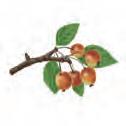


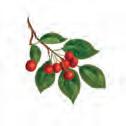


Rowan produces clusters of scarlet berries loved by redwing and fieldfare and used as a sugar substitute.
Hawthorn supports hundreds of different insects, and its berries can be used to make ketchup, chutney, jam and beverages.
Crab apple has small apples loved by hedgehogs, mice, voles, fox and deer and, if cooked, as jelly, chutney, cordial or brewed as cider, is enjoyed by us too.
Elder
Use the flowers and black berries to brew cordials, champagne and wine, whilst the berries are loved by thrushes and blackbirds.
Holly has evergreen leaves that are slow to break down, so hedgehogs, small mammals, toads and slow worms hibernate in its leaf litter.
Wild cherry has fruit suitable for making jams, puddings, chutneys, soups, vinegar, cordials, wine and beer.
Blackthorn
Like many wild fruits, sloe berries have medicinal uses as well as being used to flavour gin.
Wild plum grows in hedgerows and, whilst smaller and less sweet than domestic plums, it can be stewed to make preserves.
For more advice on planting fruit trees in your garden, visit mycoronationgarden.org
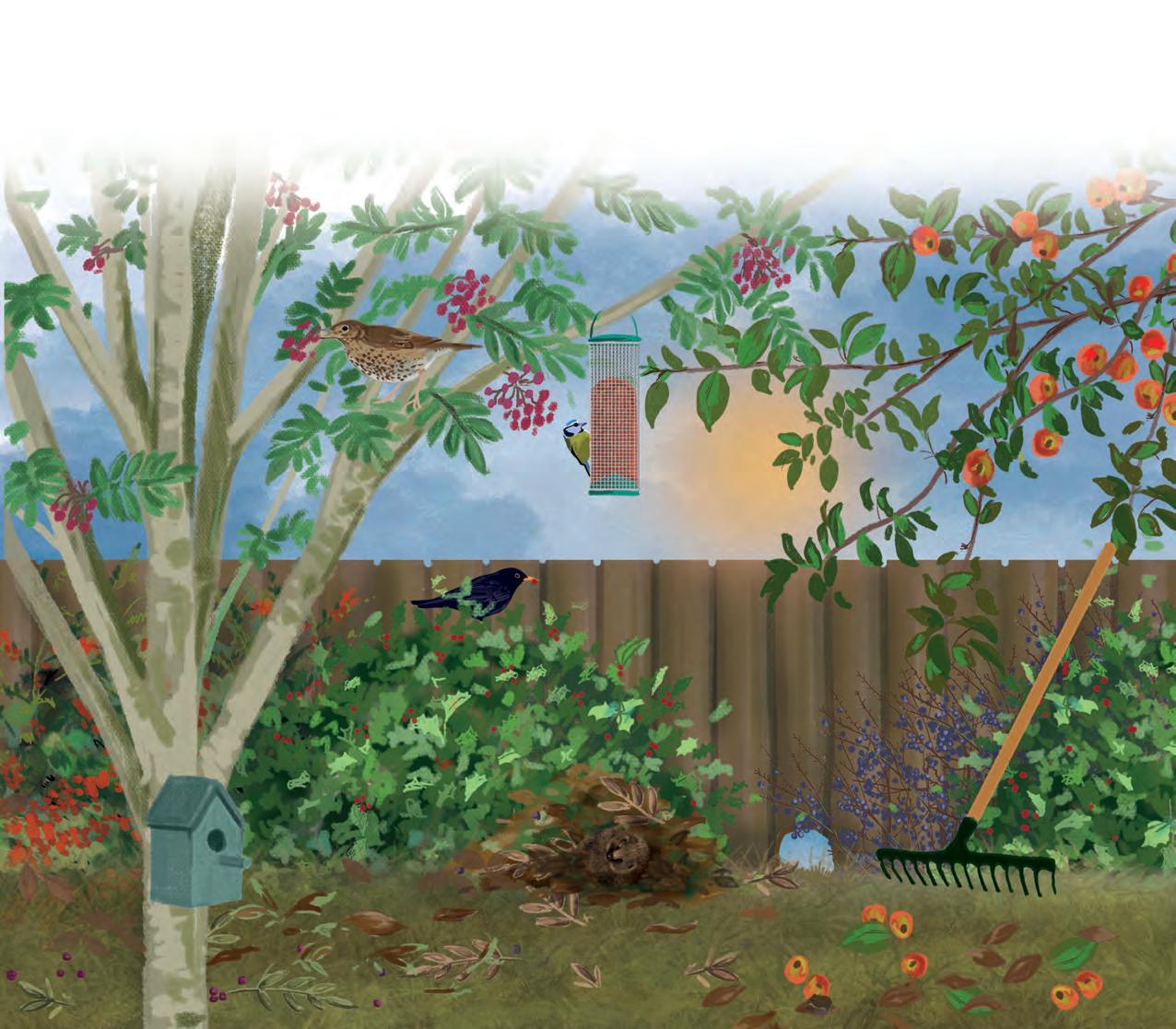
Angelika von Heimendahl, beaver reintroduction manager at The Wildlife Trusts, shares her hopes for the recovery of beaver populations across the British Isles and the incredible benefits they bring to wildlife and river ecosystems.

Beavers are a native species to Britain that were hunted to extinction about 400 years ago. However, they are on the verge of a comeback! The reasons for their disappearance were not conflicts with humans, but their usefulness. Beaver fur was highly sought after for making fashionable clothing and accessories and their scent gland excretions formed the basis of many perfumes. Even their meat was allowed to be eaten as they were considered aquatic animals.
Beavers were hunted almost, but not quite, to extinction in Europe. So the hunting switched to North America, which led to the devastation of otter and beaver populations there too. Changing European fashion in mid-19th century Europe finally made beaver hunting uneconomic but by then it was too late: in Britain beavers had already been hunted to extinction. The beaver wetlands with their dams and ditches collapsed and were forgotten and the myriad of life that depended on those wetlands gradually declined.
Beavers made a comeback
But this is not where the story ends. Beavers are incredibly adept at making a comeback. They dwindled to around 1,200 animals in Europe at the turn of the 20th century. But there are now more than 1.6 million of them scattered across the mainland, resulting from reintroductions and natural recolonisation through strict protection.
This has not been the case in islandBritain where reintroduction requires us to provide a helping hand by actively reintroducing beavers. This has led to different approaches in the devolved Governments. Scotland licensed wild beaver releases from 2009 and now has many sites with active beaver populations. Beavers are recognised as native species in Scotland and have been protected since 2019. In England the beaver was declared a native species and protected by law in 2022 but, so far, no wild release licences have been issued since the River Otter Beaver Trial completed in Devon. Despite that, some escapees have made a successful home, especially in southwest England and Kent. In Wales, we welcome the recent announcement from the Welsh Government supporting the reintroduction of beavers to Wales and looking into safeguarding their populations. There have not yet been any authorised releases into the wild, although small numbers of wildliving beavers are present.
The various trials around Britain show that beaver reintroduction is not problemfree but issues can be resolved helping humans and beavers to live and work alongside each other.
The first time I saw a wetland created by beavers, I felt a sense of peace and calmness as though some evolutionary DNA inside me recognised this landscape. It is hard to describe how natural and ordered the pathways and dams are. Beavers do not flood their territory; rather they elevate water levels gently so they can move around more easily. They ‘beaver’ away, constantly adjusting water levels depending on whether the front door of their lodge is suddenly exposed, or the inside of the lodge starts to flood.
The dams they build are not as unforgiving as human structures and beavers listen to the flow of water rushing to repair any breaches. These ecosystem engineers create dams and ponds of varying sizes. This allows many different invertebrates and fish to lay their eggs in the resulting calmer and sometimes warmer water. In turn, this increases food, shelter and breeding opportunities for an abundance of wildlife.
In Estonia, for example, mute swans take advantage of their superior water engineering skills and build their nests on top of beaver lodges to stay dry. Contrary
to common perception, they rarely fell large trees, and instead prefer to coppice smaller trees along the streams such as aspen, birch and willow. These trees have co-evolved with beavers and naturally coppice, creating the juicy side shoots that beavers love.
So, can Britain once again live alongside beavers, where they become a normal part of our environment? Should we accept the new reality of a naturedegraded Britain in which most of us have forgotten what natural abundance looked like (often called the shifting baseline syndrome)?
Beavers are herbivores – so offer no significant threat to humans, livestock or pets – and can live happily in cities or in the countryside. And, given they provide the majority of urban dwellers an opportunity to see big wildlife up close, it is surely time to let them live free back in Britain.
Moreover, beaver wetlands slow the flow from upstream rain to downstream flood and improve water quality –hydrological engineering at no cost to taxpayers. It may seem surprising that beavers can achieve so much, but we forget that for millions of years, long before human settlements and agriculture, they were the evolutionary force creating wetland ecosystems.

Despite the beaver’s success story there are regulatory hurdles to overcome. In Scotland the culling of beavers has become a control mechanism, although the carrying capacity of the country is far from reached. There are only around 1,000 beavers in Scotland. Bavaria – a similar sized region that is much more highly populated and agricultural – is home to around 25,000 beavers.
We would rather see efforts targeted at coexistence, including via translocation to other areas, rather than culling. Meanwhile, in England, we have yet to see detailed guidance from regulatory authorities to reintroduce beavers back into our rivers. In Wales, there has not been a commitment from Welsh Government to allow beavers back or recognise them as a native species.
As the General Election campaign in Summer 2024 demonstrated, there is rightful anger about the state of our rivers. They must be cleaned up and we must return the full abundance and diversity of life to our freshwaters. Beavers are a keystone species – they have a disproportionate impact on their environment given their numbers. One of the simplest and most cost-effective ways to restore our freshwaters to vitality is to welcome beavers again and watch them bring the richness back to our rivers and lakes.

Angelika von Heimendahl
is a vet and farmer, and recently joined The Wildlife Trusts as beaver reintroduction manager. She believes it is possible to create landscapes where nature thrives, people live and healthy food is produced.
The Wildlife Trusts have published A vision for the return of beavers to England and Wales making the case to end enclosures so beavers can be free in the wild again.
To support the ambition to bring back beavers to the wild, The Wildlife Trusts call on the UK and Welsh Governments to:
• Publish an ambitious beaver reintroduction strategy
• Fund farmers and land managers in the two countries to make more space for water on their land
• Support beaver management groups
• Confirm all wild beavers can remain in England and Wales
• Recognise beavers as a native species in Wales
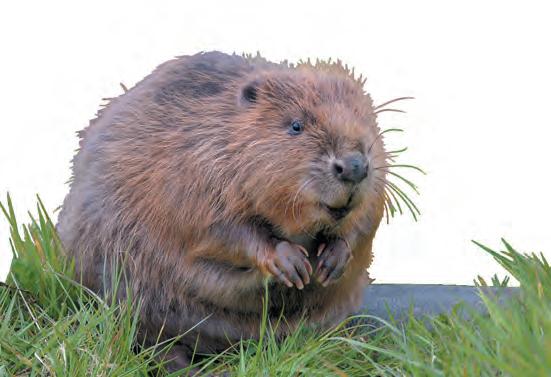
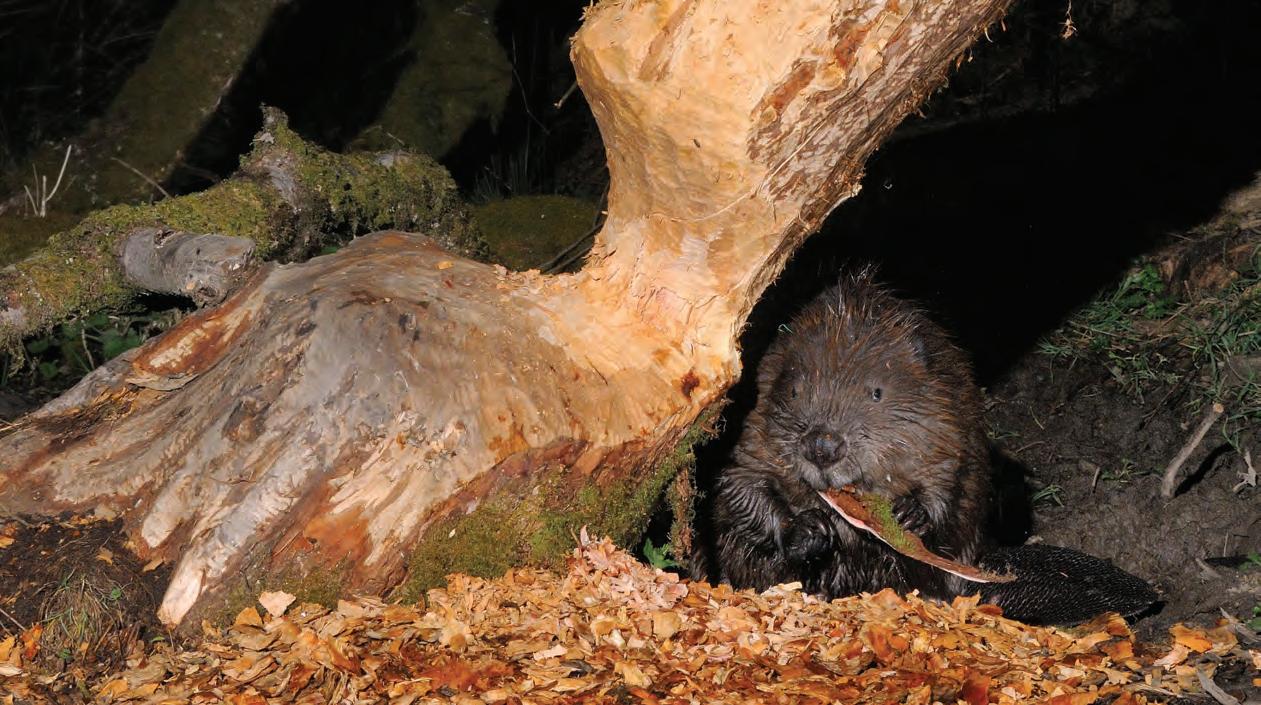

The honking calls of these large birds in flight is a clear signal that winter is on its way. Necks outstretched and beaks to the wind, swans and geese in a v-formation skein is an iconic sight.
There are three species of swans, the mute swan, whooper swan and the Bewick’s swan in the UK. The large, majestic and pure white mute swan is most recognisable and stays with us all year round in village ponds and waterways. Contrary to the name, the mute swan honks and snorts, while the whooper swan ‘bugles’ when feeding and in flight.
During the winter migration gaggles of geese flock together on UK wetlands. They graze on grassy banks, farmland, saltmarshes and seagrass meadows. The familiar Canada and greylag geese are joined by visitors such as pink-footed, white-fronted, barnacle and brent geese. Here are six of our best nature reserves for spotting swans and geese.
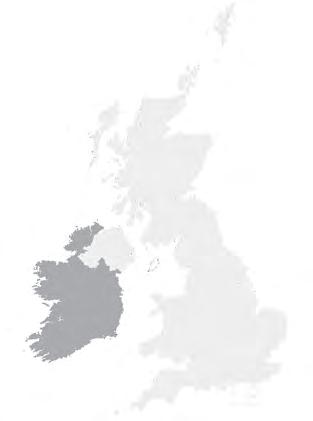
1 Montrose Basin, Scottish Wildlife Trust
The Montrose Basin is a large intertidal estuary, attracting tens of thousands of pink-footed geese every autumn. As well as being internationally important for pink-footed geese, the reserve is a wintering site for whooper swans and mute swans.
Where: Montrose, DD10 9TA
2 Holywell Pond, Northumberland Wildlife Trust
The nature reserve consists of a large pond surrounded by grassland, mature and semi-mature areas of woodland and scrub. Greylag, pink-footed, brent and Egyptian geese visit together with whooper swans, wigeon and tufted duck.
Where: Holywell, NE25 0LQ
3 Parc Slip Nature Reserve, The Wildlife Trust of South and West Wales
The wetlands and surrounding ponds at Parc Slip Nature Reserve are a fantastic haven for watching swans and geese during the autumn and winter. Its bird hides are perfectly positioned to keep an eye out for heron, teal, mallards, visiting lapwing and the resident Highland cattle that patrol the fields.
Where: Bridgend, CF32 0EH
4 Nature Discovery Centre, Berks, Bucks & Oxon Wildlife Trust
Take a seat in our shipping container bird hide or stay cosy in the ‘hide in the sky’ in the visitor centre. Both overlook the lake which is home to mute swans, Egyptian geese, Canada geese and greylag geese during winter.
Where: Thatcham, RG19 3FU
5 Blue House Farm, Essex Wildlife Trust
Flocks of over 2,000 dark-bellied brent geese travel from Siberia to graze on the marshes and wetland areas of this coastal reserve through winter. Joining them, you could spot Egyptian geese, Canada geese, brent geese and barnacle geese, alongside hundreds of waders.
Where: North Fambridge, CM3 6GU
6 Chesil Beach and The Fleet Nature Reserve, Dorset Wildlife Trust
The Fleet Lagoon in Dorset hosts a fabulous spectacle of up to 4,000 brent geese when they return from their Siberian breeding grounds. These handsome grey, black and white geese come for the winter to feast on the eel grass that grows here alongside a fabulous herd of mute swans.
Where: Weymouth, DT4 9XE
We’d love to know how your search went. Please share your best photos with us!

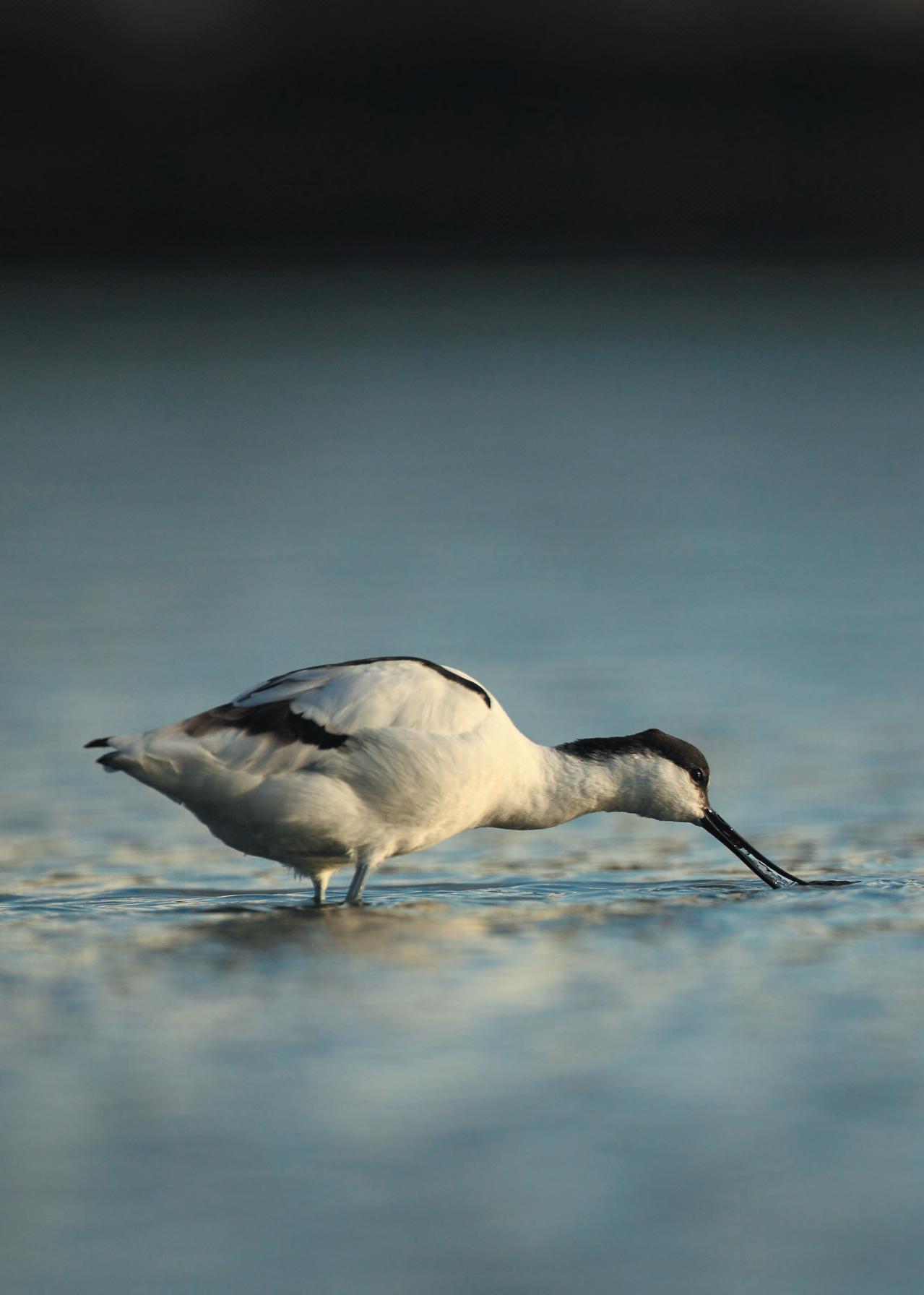
The Wildlife Trusts are embracing nature to help adapt to climate change. Eleanor Johnston, climate action lead, produces The Wildlife Trusts’ annual climate report, sharing examples of adaptation across the UK.
Our seas and coasts are places of wonder –my own fascination with them starting when I was just six years old and lucky enough to go snorkelling for the first time. Fast forward a few years and with a marine biology degree under my belt, this sense of fascination has only grown, but so too has my concern for them as I’ve witnessed the serious pressures they face, including climate change.
Rising temperatures, sea level rise, coastal erosion and changing weather patterns are some of the threats faced by our oceans linked to climate change. Our coastal reserves have been flooded with seawater more frequently and this is likely to continue as the climate changes. This threatens the sensitive freshwater coastal habitats and the species that depend on them, such as the elegant avocet, which feed and raise their chicks in the shallow pools and muddy banks of coastal marshes. If these habitats are lost, these birds have nowhere to feed and breed.
Embracing nature
Over the last couple of years, The Wildlife Trusts’ have produced an annual climate adaptation report, with the latest, Embracing Nature, highlighting the work we’re involved in across the UK to adapt to climate change. From peatland and grassland habitat restoration to woodland creation and natural flood management, we are helping nature and communities adapt to climate change.
This includes multiple projects from Wildlife Trusts and partners to create and restore marine and coastal habitats. These innovative programmes not only help our coasts adapt, but also provide a home for a range of wildlife and remove carbon from the atmosphere, playing a big role in tackling climate change.
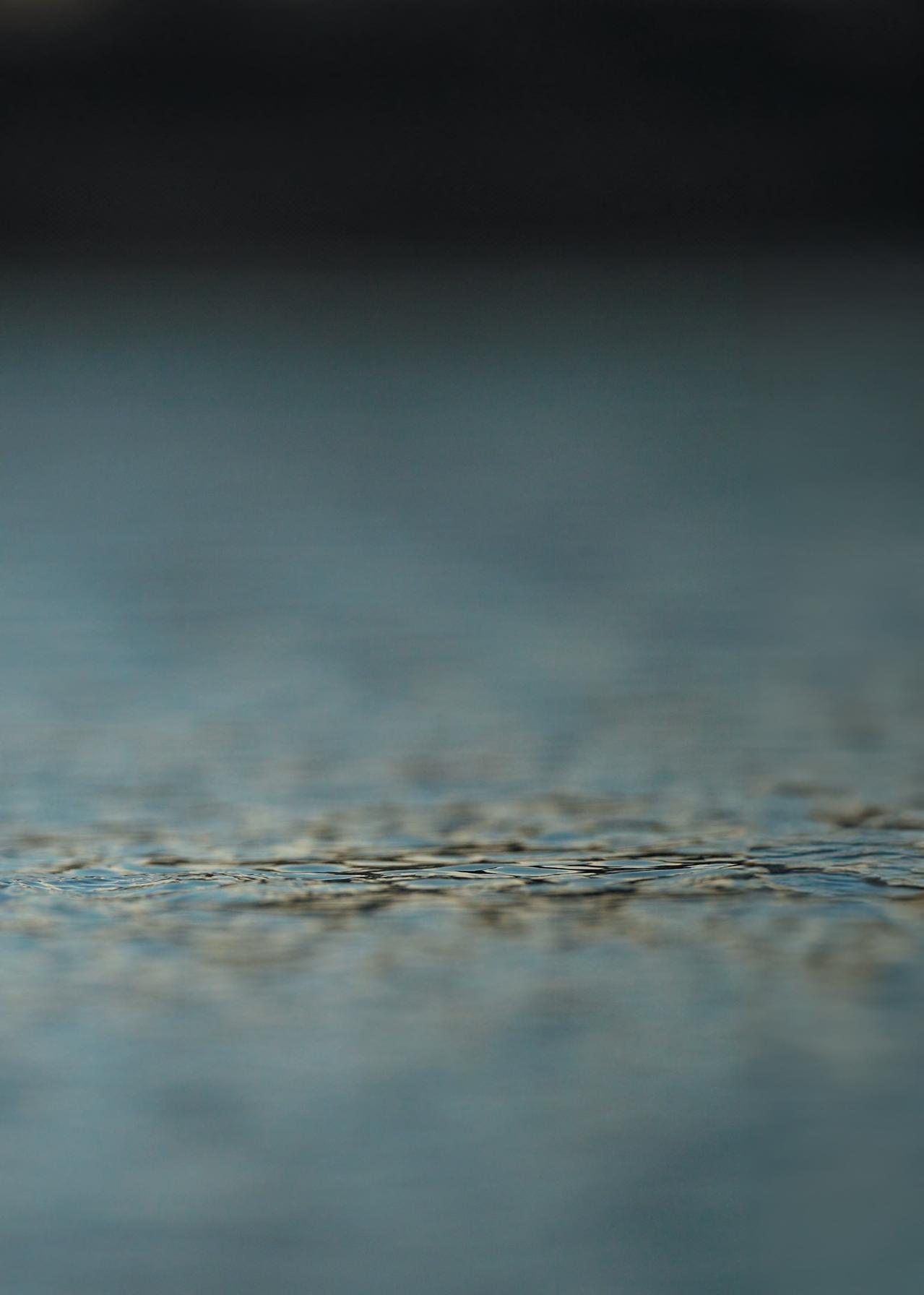
Adaptation work ‘on the ground’
Examples of Wildlife Trusts in action include Norfolk Wildlife Trust who alongside the Environment Agency, have been working to adapt the Cley and Salthouse Marshes. They have rejuvenated reedbeds and moved a section of the ‘New Cut’ flood drain to better evacuate flood water and help the marshes maintain freshwater coastal habitats. As well as wading birds such as redshank and avocet, the restored areas will support the fascinating and elusive bittern, which hunt for eels and other fish amongst the reedbeds. One day I hope to hear its booming foghorn-like calls on a visit there!
This summer, I was lucky enough to visit Spurn National Nature Reserve to see the work of Yorkshire and Lincolnshire Wildlife Trusts who are restoring sand dunes, seagrass and saltmarsh habitat, alongside native oysters as part of the Wilder Humber project with Ørsted. One of their aims is to rebuild the Humber’s lost native oyster population to over half a million oysters!
Having grown up holidaying on the north coast of Wales, I am also really excited about the seagrass restoration being done by North Wales Wildlife Trust as part of Seagrass Ocean Rescue. A staggering 200,000 seagrass seeds were planted in spring last year and the growth of seagrass at these sites is now being monitored, with plans for more planting to take place.
These are just a handful of the brilliant projects happening across The Wildlife Trusts, which are embracing nature to adapt to climate change! This work gives me hope that we really can help if we act now.

Eleanor Johnston leads climate action work at The Wildlife Trusts supporting the 46 Wildlife Trusts in mitigating and adapting to climate change.
There are many ways to help our coasts adapt to climate change, so if, like me, you feel inspired to take action to save them, then here are a few ideas you might like to try:
• Help your local Wildlife Trust – whether it’s helping make seagrass seed bags or monitoring coastal marshes, this work couldn’t happen without our volunteers. Get in touch and see how you can help!
• Collect data – check out our citizen science projects such as Shoresearch and Seasearch and help us collect important data whilst enjoying spending time at the coast (what’s not to like?)!
• Get adaptation noticed – help us make climate change adaptation a government priority by asking your local MP, MSP or AM what is being done in your area.

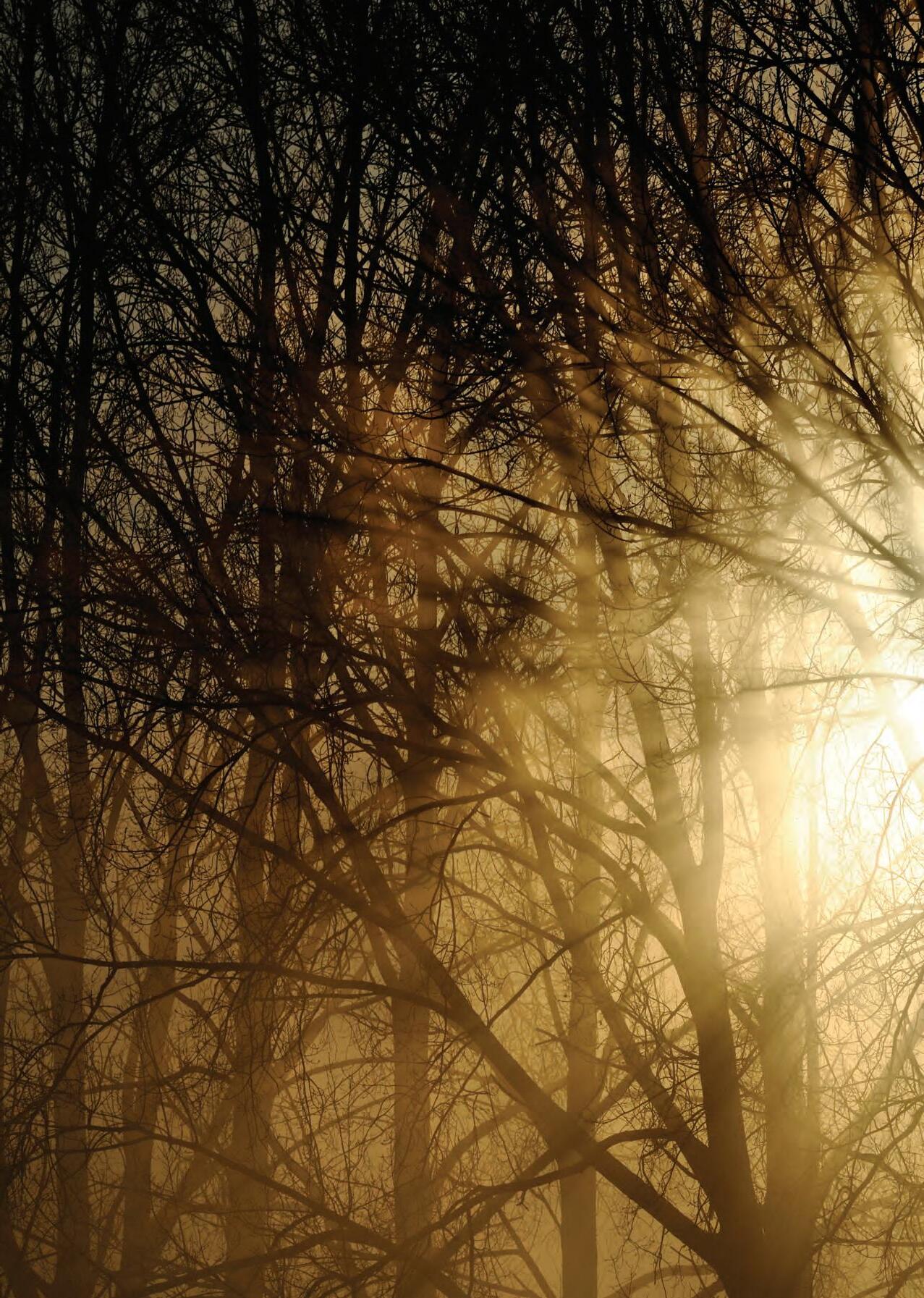
Some days it feels like we are in a desperate scramble to respond to the challenge of species and habitat loss, as well as an intensifying climate emergency. One upside of our experience of the sharpness of urgency has been a broadening in the category of environmentalism. Now it includes new or previously marginalised stakeholders and overlooked forms of care for nature.
As a general rule, sustainability has tended towards a default of elite, white, secular and scientific. In the research I was involved in last year on project Spotlight*, we identified a massive upswell of enthusiasm for environmental care and action among people of colour in the UK. A significant number of our respondents also linked their concerns to religious and spiritual traditions and identities.
These finding supported work I’ve done alongside everyday activists and environmentalists, where I’ve seen an exciting range of new initiatives coming up in the context of religious communities. This includes the Sikh Guru Nanak Sacred Forest project, aiming to establish a new network of sacred forests across the world. British Muslims are drawing on the Quran and Hadith to reclaim forms of thoughtful stewardship of nature.
This can also be seen in urban ecology projects: British Bahu Trust mosques are covered with solar panels and proactive in leading community clean-ups. Cambridge Central mosque is a true eco-mosque with a near-zero carbon footprint. The Eco-Church network, has grown from 250 to more than 5,000 British churches in a decade, making it one of the largest community networks of local environmental action groups in the UK. Woodlands, nature reserves, and other nonreligious environmental charities are also connecting with their stakeholders in more holistic ways. Given that so much of our work restoring the landscapes we care about is about re-
establishing forms of connection, it makes sense that many people are re-discovering their own environmentalism in the context of personal faith and spirituality.
But while conservation as a genre is opening up, there is still a lot of work to do. Are there aspects of ourselves that we still hold back and fence off from our concerns for wildlife? For example, the natterjack toad, hazel dormouse and hedgehog are all under threat of extinction. We might try to stretch our awareness to bring creativity to forms of love for creatures that we might find unlovely or pause to learn about new kinds of beauty.
By bringing spirituality to nature it can also help us navigate feelings of loss and disconnection, like the process of mourning a lost-through-melting Icelandic glacier. This might take the form of a slow walk, drawing close and leaning in to nature, even though we may want to flee for fear of grief. Why not treat walking footpaths, hills or the spectacular but fragile British peatlands as an eco-pilgrimmage?
It’s especially exciting to me that we are finally bringing spirituality to nature conservation as this can help us to forge deeper relationships, harmony and forms of connection with habitats and creatures.
*Project Spotlight is an initiative engaging people of colour with nature and climate change. You can learn more about the project at climateexperiences.org
This article by Jeremy Kidwell precedes an upcoming blog series by The Wildlife Trusts exploring the intersection of nature conservation and climate change, religious faiths and spirituality. Starting towards the end of 2024, each blog will focus on religious festivals or awareness days that highlight diverse spiritual perspectives on the natural world. View all blogs from The Wildlife Trusts at wildlifetrusts.org/blog

Jeremy Kidwell is an associate professor in theology at the University of Birmingham. He is the author or editor of a range of books including most recently a collection of essays edited with Stefan Skrimshire called Religion and Extinction
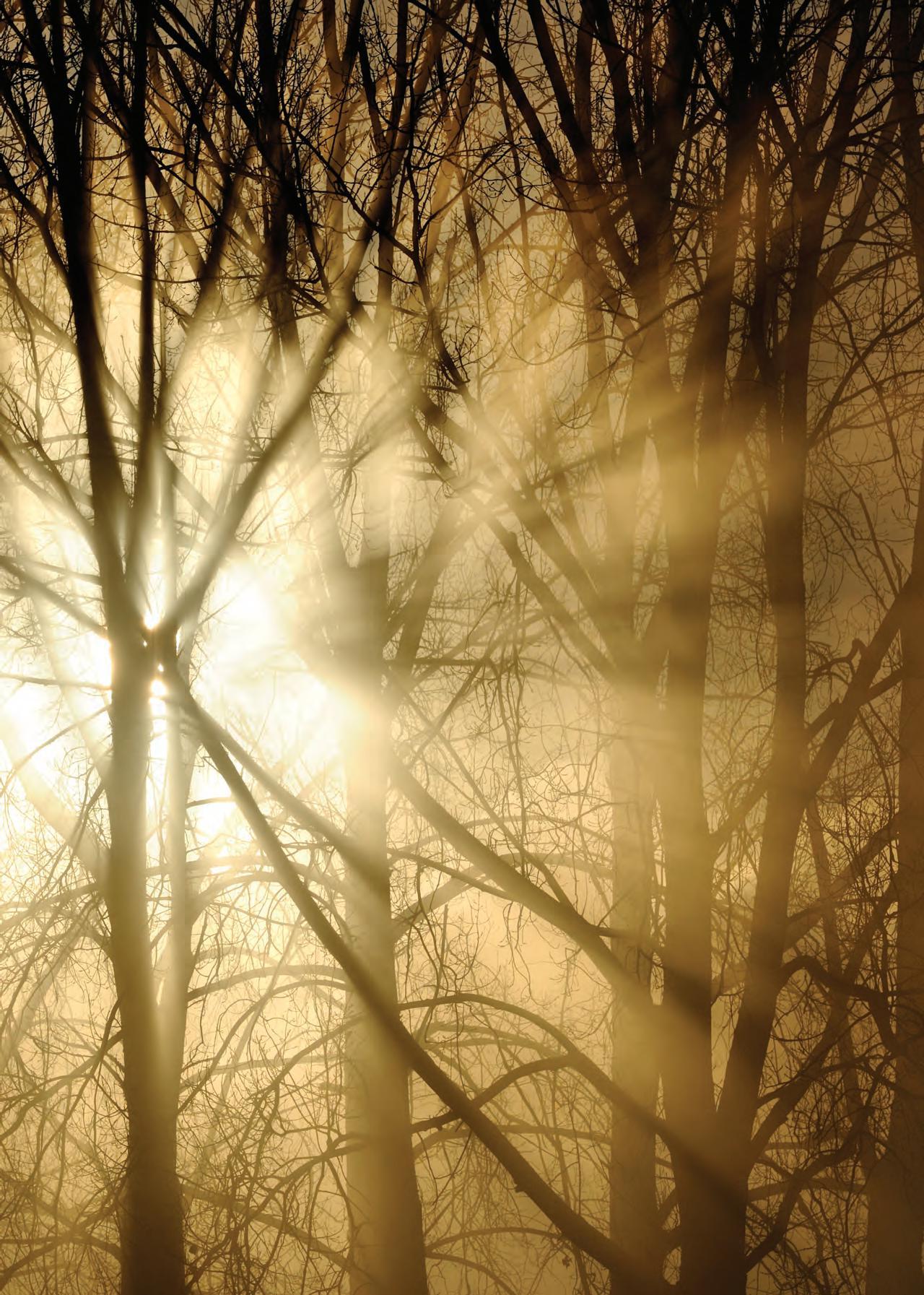
Your support helped us achieve all this and more over the last year…
60,000+ members, another new high
2 habitat banks established at Duxford Old River and Ludgershall Meadows
1,700 volunteers
7 projects successfully completed
Delivered wildlifefriendly land management advice over 4,258 ha
The Oxfordshire Wildlife Sites Project provided specialist advice to 35 Local Wildlife Sites
321 sites surveyed for water voles
Berkshire Buckinghamshire & Oxfordshire Wildlife Trust
£564,786 of external funding secured for five new conservation projects
364 pieces of local and national media coverage
10.5% increase in social media followers
Worked with partners, including Buckinghamshire Council, the Floodplain Meadows Partnership, Chilterns National Landscape, local councils and landowners
Delivered conservation projects across a total area of 97,084 ha
86% of planning applications responded to by BBOWT were withdrawn, refused or amended with improved considerations for wildlife
937 campaigning Wildlife Ambassadors